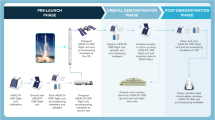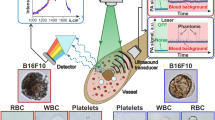Abstract
We have developed a technique for determining cell concentration in a hollow fiber bioreactor based on 23Na nuclear magnetic resonance (NMR) spectroscopy. Cell concentrations determined with this method agreed closely with concentrations calculated from 31P NMR nucleoside triphosphate (NTP) measurements and oxygen consumption rate measurements. Oxygen transfer limitations, which can complicate cell mass determinations based on oxygen consumption rates, were shown to be negligible for the bioreactor used. Specific antibody production rates in hollow fiber culture, calculated from these cell number estimates, were similar to those found in suspension culture for this cell line.
This is a preview of subscription content, access via your institution
Access options
Subscribe to this journal
Receive 12 print issues and online access
$209.00 per year
only $17.42 per issue
Buy this article
- Purchase on Springer Link
- Instant access to full article PDF
Prices may be subject to local taxes which are calculated during checkout
Similar content being viewed by others
References
Heath, C. and Belfort, G. 1987. Immobilization of suspended mammalian cells: Analysis of hollow fiber and microcapsule bioreactors. Advances in Biochemical Engineering 34: 1–31.
Tharakan, J.P., Gallagher, S.L. and Chao, P.C. 1988. Advances in Biotechnological Processes, Vol. 7, p. 153–184. Alan R. Liss, Inc., New York.
Gillies, R.J., Chresand, T.J., Drury, D.D. and Dale, B.E. 1986. Design and application of bioreactors for analyses of mammalian cells by NMR. Reviews of Magnetic Resonance in Medicine 1(2): 155–179.
Fernandez, E.J., Mancuso, A., Murphy, M.K., Blanch, H.W. and Clark, D.S. 1990. Nuclear magnetic resonance methods for observing the intracellular environment of mammalian cells. Ann. N. Y. Acad. Sci. 589: 458–475.
Fernandez, E.J. and Clark, D.S. 1987. NMR spectroscopy: A non-invasive tool for studying intracellular processes. Enzyme and Microb. Technol. 9: 259–271.
Gadian, D.G. 1982. Nuclear Magnetic Resonance and Its Application to Living Systems. Oxford University Press, Oxford.
Custer, L.M. 1988. Physiological Studies of Hybridoma Cultivation in Hollow Fiber Bioreactors. Ph.D. Dissertation, University of California, Berkeley.
Ehrlich, K., Stewart, E. and Klein, E. 1978. Artificial capillary perfusion cell culture: Metabolic studies. In Vitro 14(5): 443–450.
Chresand, T.J., Gillies, R.J., Dale, B.E. 1988. Optimum fiber spacing in a hollow fiber bioreactor. Biotechnology and Bioengineering 32: 983–992.
Miller, W.M., Wilke, C.R. and Blanch, H.W. 1988. Transient responses of hybridoma cells to lactate and ammonia pulse and step changes in continuous culture. Bioprocess Engineering 3: 113–122.
Miller, W.M., Wilke, C.R. and Blanch, H.W. 1989. Transient responses of hybridoma cells to nutrient additions in continuous culture: I. Glucose pulse and step changes and II. Glutamine pulse and step changes. Biotechnology and Bioengineering 33: 477–486.
Miller, W.M., Wilke, C.R. and Blanch, H.W. 1987. Effects of dissolved oxygen on hybridoma growth and metabolism in continuous culture. J. Cell. Physiol. 132: 524–530.
Boraston, R., Thompson, P.W., Garland, S. and Birch, J.R. 1984. Growth and oxygen requirements of antibody producing mouse hybridoma cells in suspension culture. Developments in Biological Standardization 55: 103–111.
Miller, W.M., Blanch, H.W. and Wilke, C.R. 1988. A kinetic analysis of hybridoma growth and metabolism in batch and continuous culture: Effect of nutrient concentration, dilution rate and pH. Biotechnology and Bioengineering 32: 947–965.
Miller, W.M., Wilke, C.R. and Blanch, H.W. 1988. Transient responses of hybridoma metabolism to changes in the oxygen supply rate in continuous culture. Bioprocess Engineering 3: 103–111.
Blute, T., Gillies, R.J. and Dale, B.E. 1988. Cell density measurement in hollow fiber bioreactors. Biotechnology Progress 4(4): 202–209.
Gupta, R.K. 1987. 23Na NMR spectroscopy of intact cells and tissues, p. 1–32. In: NMR Spectroscopy of Cells and Organisms, Vol. 2, R. K. Gupta (Ed.) CRC Press, Boca Raton, FL.
Wang, D.I.C., Cooney, C.L., Demain, A.L., Dunnill, P., Humphrey, A.E., Lilly, M.D. 1979. Fermentation and Enzyme Technology. John Wiley and Sons New York, NY.
Reitzer, L.J., Wice, B.M. and Kennell, D. 1979. Evidence that glutamine, not sugar is the major energy source for cultured HeLa cells. J. Biol. Chem. 254: 2669–2676.
Altshuler, G.L., Dziewulski, D.M., Sowek, J.A. and Belfort, G. 1986. Continuous hybridoma growth and monoclonal antibody production in hollow fiber reactors-separators. Biotechnology and Bioengineering 28: 646–658.
Wiemann, M.C. et al. 1983. Human and murine hybridomas: Growth and monoclonal antibody production in the artificial capillary culture system. Clinical Research 31: 511A.
Cima, L.G. 1988. Anchorage-Dependent Mammalian Cell Cultures in Hollow Fiber Reactors: Cell Metabolism and Mass Transfer Limitations. Ph.D. Dissertation, University of California, Berkeley.
Benson, B.B. and Krause, D., Jr., 1976. Empirical laws for dilute aqueous solutions of nonpolar gases. J. Chem. Phys. 64: 689–709.
Schumpe, A., Adler, I. and Deckwer, W.D. 1978. Solubility of oxygen in electrolyte solutions. Biotechnology and Bioengineering 20: 145–150.
Derome, A.E. 1987. Modern NMR Techniques for Chemistry Research. Pergamon Press, New York, NY.
Author information
Authors and Affiliations
Rights and permissions
About this article
Cite this article
Mancuso, A., Fernandez, E., Blanch, H. et al. A Nuclear Magnetic Resonance Technique for Determining Hybridoma Cell Concentration in Hollow Fiber Bioreactors. Nat Biotechnol 8, 1282–1285 (1990). https://doi.org/10.1038/nbt1290-1282
Received:
Accepted:
Issue Date:
DOI: https://doi.org/10.1038/nbt1290-1282



